

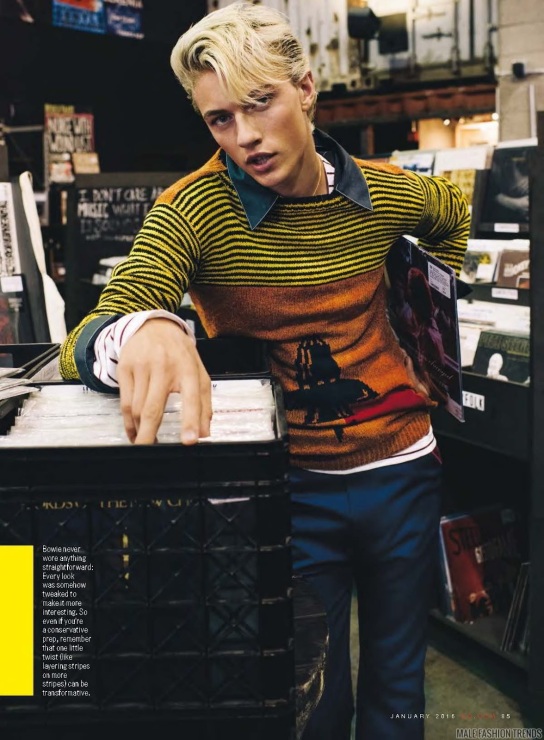



Model: Lucky Blue Smith
Photographer: Sebastian Kim
GQ, January 2016







Model: Lucky Blue Smith
Photographer: Sebastian Kim
GQ, January 2016
Tim Walker and actress Tilda Swinton created a series of phantasmagorias inspired by artists Salvador Dalí, Giorgio de Chirico, Remedios Varo, Leonora Carrington, and other muses and collaborators of English eccentric, poet, and surrealist collector Edward James.
 Cover of W magazine. Modern Beauty issue. May 2013
Cover of W magazine. Modern Beauty issue. May 2013
 Givenchy by Riccardo Tisci dress; Cornelia James gloves
Givenchy by Riccardo Tisci dress; Cornelia James gloves
 Vera Wang Collection dress; Vicki Beamon lips and fingertips; Cornelia James gloves
Vera Wang Collection dress; Vicki Beamon lips and fingertips; Cornelia James gloves
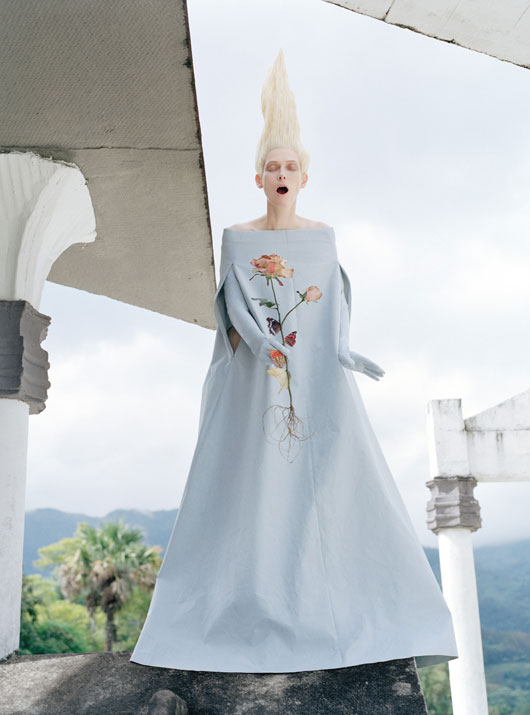 Maison Martin Margiela dress and gloves
Maison Martin Margiela dress and gloves
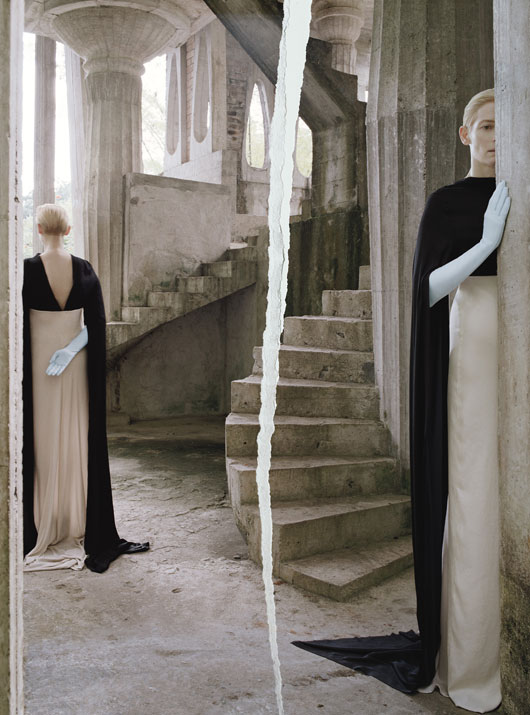 Ann Demeulemeester dress; Cornelia James gloves
Ann Demeulemeester dress; Cornelia James gloves
 Balmain jacket; Max Mara jacket; Swinton’s own Olivier Saillard gloves
Balmain jacket; Max Mara jacket; Swinton’s own Olivier Saillard gloves
 Rochas dress; National Theatre Costume Hire underskirt; Cornelia James gloves; Céline pumps
Rochas dress; National Theatre Costume Hire underskirt; Cornelia James gloves; Céline pumps
 Angels the Costumiers cape; Gucci gown; Vicki Beamon mask; Cornelia James gloves
Angels the Costumiers cape; Gucci gown; Vicki Beamon mask; Cornelia James gloves
 Azzedine Alaïa top, skirt, and shoes; Emilio Cavallini bodysuit; Alexander McQueen headpiece
Azzedine Alaïa top, skirt, and shoes; Emilio Cavallini bodysuit; Alexander McQueen headpiece
 Louis Vuitton dress and shoes; Cornelia James gloves; Emilio Cavallini tights
Louis Vuitton dress and shoes; Cornelia James gloves; Emilio Cavallini tights
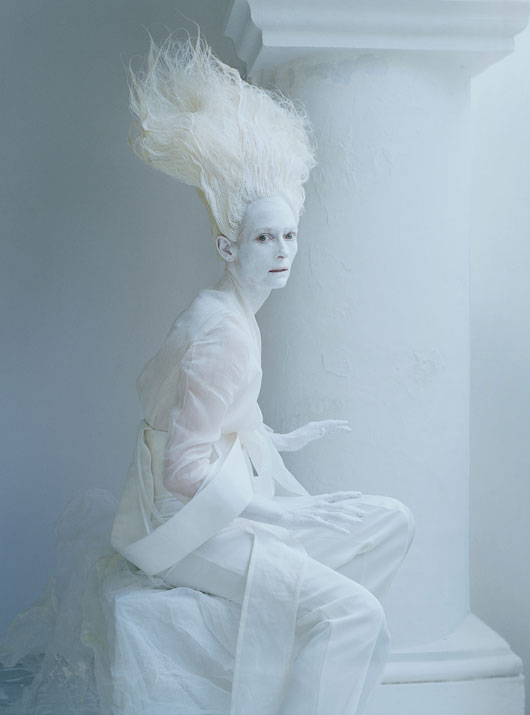 Haider Ackermann shirt and trousers
Haider Ackermann shirt and trousers
 Mary Katrantzou dress; Cornelia James gloves
Mary Katrantzou dress; Cornelia James gloves
 Giorgio Armani blouse, skirt, and pants; Haider Ackermann dress; Ann Demeulemeester top; Cornelia James gloves; Prada gaiters and socks
Giorgio Armani blouse, skirt, and pants; Haider Ackermann dress; Ann Demeulemeester top; Cornelia James gloves; Prada gaiters and socks
 “The Journey of a star, captured in a flash”. Annie Leibovitz and Mikhail Baryshnikov. Annie’s studio, New York
“The Journey of a star, captured in a flash”. Annie Leibovitz and Mikhail Baryshnikov. Annie’s studio, New York
 “Is there any greater journey than love?” Steffi Graf and Andre Agassi. New York
“Is there any greater journey than love?” Steffi Graf and Andre Agassi. New York
 “There are journeys that turn into legends”. Sean Connery, Bahamas Islands
“There are journeys that turn into legends”. Sean Connery, Bahamas Islands
 “Every journey began in Africa”- Ali and Bono. Uganda
“Every journey began in Africa”- Ali and Bono. Uganda
 “A journey bring us face to face with ourselves”. Mikhail Gorbachev, Berlin, Germany
“A journey bring us face to face with ourselves”. Mikhail Gorbachev, Berlin, Germany
 “Some stars show you the way”. Muhammad Ali and a rising star. Phoenix, Arizona
“Some stars show you the way”. Muhammad Ali and a rising star. Phoenix, Arizona
 “Three exceptional journeys. One historic game”. Pelé, Diego Armando Maradona and Zinadine Zidane. Madrid, Spain
“Three exceptional journeys. One historic game”. Pelé, Diego Armando Maradona and Zinadine Zidane. Madrid, Spain
 “Some journeys change mankind forever”. Sally Ride, Buzz Aldrin and Jim Lowell. California
“Some journeys change mankind forever”. Sally Ride, Buzz Aldrin and Jim Lowell. California
 “A single journey can change the course of a life”. Angelina Jolie. Cambodia
“A single journey can change the course of a life”. Angelina Jolie. Cambodia
 “Inside every story, there is a beautiful journey”. Sofia Coppola and Francis Ford Coppola. Buenos Aires, Argentina
“Inside every story, there is a beautiful journey”. Sofia Coppola and Francis Ford Coppola. Buenos Aires, Argentina
Louis Vuitton Core Values campaigns revisit the brand’s heritage with a completely fresh interpretation of the concept of travel in an emotional sense, viewed as a personal journey, a process of self-discovery. The campaign debuted in September 2007 in major international titles featuring no other but the former Soviet statesman Mikhail Gorbachev, the French movie siren Catherine Deneuve, the founding member of The Rolling Stones Keith Richards and the tennis power couple Andre Agassi and Steffi Graf, among many other influential and famous people.
Pietro Beccari, Senior VP of Communication explains this shot: “Not only does it capture the unique quality of a father-daughter relationship, in which both are enriched by a shared experience, but it also evokes the heritage of Louis Vuitton with its suggestion of know-how being passed from one generation to the next.”
Celebrating the 40th anniversary of Apollo 11’s first steps on the Moon, the ad features legendary astronauts Sally Ride (first American woman in space), Buzz Aldrin (Apollo 11, first steps on the Moon, 1969) and Jim Lovell (Apollo 13) looking up in the Californian desert night sky.
In 2010 Brazil’s Pelé, Argentina’s Diego Maradona and France’s Zinedine Zidane all won football’s ultimate prize, and all wore the emblematic N°10 shirt. They met up in the Café Maravillas, a typical bar in Madrid, and were tempted into a game of table football. The image leaves the suspense intact, but clearly captures the atmosphere of fun and friendly rivalry.
Given the photographer of all Core Value campaigns personal and financial troubles in 2010, Louis Vuitton wished to offer support in the most positive way and suggested that Annie Leibovitz become the next campaign’s hero. She accepted on the condition that she appears alongside for friend and one of the foremost dancers of the 20th century, Mikhail Baryshnikov.
This is the first time U2 frontman Bono has appeared in an ad sans his bandmates, but instead with his wife Ali Hewson. It’s also the first time that a label other than Louis Vuitton is getting a fashion credit – the pair are wearing their own clothing line Edun, a line of ethical fashion. Proceeds from the sales will go to TechnoServe, which supports sustainable farming in Africa.
As the pioneer of the art du voyage, Louis Vuitton is always on the look out for the exceptional people with extraordinary journeys. The question is who will be next?
 Ever since Annie Leibovitz photographed Demi Moore, for the front cover of Vanity Fair magazine, maternity photographs have become increasingly popular. Undoubtedly this photo gave birth to the modern maternity portrait
Ever since Annie Leibovitz photographed Demi Moore, for the front cover of Vanity Fair magazine, maternity photographs have become increasingly popular. Undoubtedly this photo gave birth to the modern maternity portrait
 The supermodel swelled with pride as she showed off her seven-month belly (filled with son Presley) in the June 1999 issue of W. Cindy Crawford was originally slated to wear a gown, but she apparently didn’t look pregnant enough in it. Problem solved. Photo: Michael Thompson
The supermodel swelled with pride as she showed off her seven-month belly (filled with son Presley) in the June 1999 issue of W. Cindy Crawford was originally slated to wear a gown, but she apparently didn’t look pregnant enough in it. Problem solved. Photo: Michael Thompson
 It’s only fitting that Brooke Shields was Vogue‘s first visibly pregnant cover model. After all, she’d also been the fashion bible’s youngest cover model back in 1980, when she was 14. She was 37 and eight months along with daughter Rowan on the April 2003 issue, on which she sported a sheer, soaking-wet Krizia gown.Photo: Annie Leibovitz
It’s only fitting that Brooke Shields was Vogue‘s first visibly pregnant cover model. After all, she’d also been the fashion bible’s youngest cover model back in 1980, when she was 14. She was 37 and eight months along with daughter Rowan on the April 2003 issue, on which she sported a sheer, soaking-wet Krizia gown.Photo: Annie Leibovitz
 The Italian bombshell — best known to American audiences for her work in The Matrix Reloaded — had more than vanity in mind when she posed nude for the cover of a 2004 edition of Vanity Fair: The wife of French actor Vincent Cassel reportedly disrobed to protest Italy’s laws against the use of donor sperm. Nicely done, Monica. Photo: Fabrizio Ferri
The Italian bombshell — best known to American audiences for her work in The Matrix Reloaded — had more than vanity in mind when she posed nude for the cover of a 2004 edition of Vanity Fair: The wife of French actor Vincent Cassel reportedly disrobed to protest Italy’s laws against the use of donor sperm. Nicely done, Monica. Photo: Fabrizio Ferri
 Vanity Fair Italy, March 2010. Photo by Tyen
Vanity Fair Italy, March 2010. Photo by Tyen
 Six months pregnant with second son Jayden James, the then-spiraling pop star Britney Spears disrobed for the August 2006 issue of Harper’s Bazaar. Necklace: Louis Vuitton. Photo: Alexi Lubomirki
Six months pregnant with second son Jayden James, the then-spiraling pop star Britney Spears disrobed for the August 2006 issue of Harper’s Bazaar. Necklace: Louis Vuitton. Photo: Alexi Lubomirki
 November 2006 issue of Britain’s Q magazine. In the interview, Britney revealed she was craving ice (and evidently lollipops). Photo: James Dimmock
November 2006 issue of Britain’s Q magazine. In the interview, Britney revealed she was craving ice (and evidently lollipops). Photo: James Dimmock
 Milla Jovovich gnawed on that gauzy curtain for a good cause. Her 2007 shoot for Jane magazine benefited charity. Soon after, she gave birth to daughter Ever Gabo with Resident Evil writer-director Paul William Scott Anderson.
Milla Jovovich gnawed on that gauzy curtain for a good cause. Her 2007 shoot for Jane magazine benefited charity. Soon after, she gave birth to daughter Ever Gabo with Resident Evil writer-director Paul William Scott Anderson.
 Christina Aguilera was nearly done baking son Max when she ditched her duds (but not her Louboutins or hair dye) for the January 2008 issue of Marie Claire. Photo: Ruven Afanador
Christina Aguilera was nearly done baking son Max when she ditched her duds (but not her Louboutins or hair dye) for the January 2008 issue of Marie Claire. Photo: Ruven Afanador
 Known for her sometimes outrageous red carpet poses, Paula Patton looked perfectly goddess-like draped in nude chiffon with curly hair and natural make-up on the May 2010 cover of Ebony. And the magazine happened to hit stands after the actress, who’s married to R&B crooner Robin Thicke, gave birth to son Julian Fuego
Known for her sometimes outrageous red carpet poses, Paula Patton looked perfectly goddess-like draped in nude chiffon with curly hair and natural make-up on the May 2010 cover of Ebony. And the magazine happened to hit stands after the actress, who’s married to R&B crooner Robin Thicke, gave birth to son Julian Fuego
 Dem babies, as Mariah Carey affectionately nicknamed still-gestating twins Moroccan and Monroe, kicked at their mom’s belly through most of her photo shoot for the April 18, 2011, issue of Life & Style. We assume they were kicking in protest over this awkward pose
Dem babies, as Mariah Carey affectionately nicknamed still-gestating twins Moroccan and Monroe, kicked at their mom’s belly through most of her photo shoot for the April 18, 2011, issue of Life & Style. We assume they were kicking in protest over this awkward pose
 Proving that supermodels really are superior life forms, a shaggy-haired Claudia Schiffer was pregnant with her third child, daughter Cosima, when she stripped down for a Karl Lagerfeld-directed shoot in the June 2010 issue of German Vogue
Proving that supermodels really are superior life forms, a shaggy-haired Claudia Schiffer was pregnant with her third child, daughter Cosima, when she stripped down for a Karl Lagerfeld-directed shoot in the June 2010 issue of German Vogue
 Mrs. Orlando Bloom, Miranda Kerr, was six-and-a-half months pregnant with son Flynn when she tastefully revealed all in the December 2010 issue of W. Photo by Patrick Demarchelier
Mrs. Orlando Bloom, Miranda Kerr, was six-and-a-half months pregnant with son Flynn when she tastefully revealed all in the December 2010 issue of W. Photo by Patrick Demarchelier
 The 41-year-old actress bared her soul (per the cover’s tagline) and lots more in the November 2011 issue of Ebony. She welcomed her second son, Kez, that same month. “The medical [profession] tries to tell every woman, ‘Have your babies before 40 because you shouldn’t have children after 40. Society tells us, ‘Get married before 30, because no man wants a woman after 30.’ You are not half the woman you’re gonna be until you turn 30. You’re not even half of that woman yet. So I think if we’d just take our time as women, and do what comes natural to us and for us, we would make fewer mistakes.”
The 41-year-old actress bared her soul (per the cover’s tagline) and lots more in the November 2011 issue of Ebony. She welcomed her second son, Kez, that same month. “The medical [profession] tries to tell every woman, ‘Have your babies before 40 because you shouldn’t have children after 40. Society tells us, ‘Get married before 30, because no man wants a woman after 30.’ You are not half the woman you’re gonna be until you turn 30. You’re not even half of that woman yet. So I think if we’d just take our time as women, and do what comes natural to us and for us, we would make fewer mistakes.”
 The latest star to go au naturel, Jessica undressed for the April 2012 issue of Elle and revealed she’s expecting a girl with fiancé Eric Johnson. Photo: Carter Smith. Styled by Joe Zee
The latest star to go au naturel, Jessica undressed for the April 2012 issue of Elle and revealed she’s expecting a girl with fiancé Eric Johnson. Photo: Carter Smith. Styled by Joe Zee
 Keith Richards photographed by Annie Leibovitz. Louis Vuitton 2008 ad campaign. “Some journeys cannot be put into words. New York. 3 am. Blues in C,” runs the slogan of the ad.
Keith Richards photographed by Annie Leibovitz. Louis Vuitton 2008 ad campaign. “Some journeys cannot be put into words. New York. 3 am. Blues in C,” runs the slogan of the ad.

 The founding member of The Rolling Stones was captured in a New York hotel room that he transformed by draping black Alexander McQueen’s skull-print scarves over the lamps and placing a skull on a bedside table.
The founding member of The Rolling Stones was captured in a New York hotel room that he transformed by draping black Alexander McQueen’s skull-print scarves over the lamps and placing a skull on a bedside table.
 “Good” Kate Moss on W‘s March 2012 cover
“Good” Kate Moss on W‘s March 2012 cover
Fashion: Vera Wang’s silk lace dress. Erdem habit; Early Halloween vintage lace. Beauty: Dolce & Gabbana Perfect Finish Powder Foundation in Warm; Smooth Eye Colour Duo in Cinnamon; Secret Eyes Mascara in Coffee; Classic Cream Lipstick in Petal; Fekkai Advanced Salon Technician Highlight Care Illuminating Cream
 “Bad” Kate Moss on W’s March 2012 cover
“Bad” Kate Moss on W’s March 2012 cover
Fashion: Gucci’s silk georgette dress. Freire flower.Beauty: SK-II Skin Signature Cream; Dolce & Gabbana Makeup Perfect Finish Creamy Foundation in Ivory; Smooth Eye Color Quad in Femme Fatale; Secret Eyes Mascara in Coffee; Classic Cream Lipstick in Ultra
 The Row’s embroidered silk caftan. VBH Luxury 18k oxidized white gold and diamond necklace; Lorraine Schwartz 18k white gold and black and white diamond ring; Carolina Amato gloves
The Row’s embroidered silk caftan. VBH Luxury 18k oxidized white gold and diamond necklace; Lorraine Schwartz 18k white gold and black and white diamond ring; Carolina Amato gloves
 Louis Vuitton’s silk organza dress. Paul Hanlon custom headpiece
Louis Vuitton’s silk organza dress. Paul Hanlon custom headpiece
 Jil Sander’s cotton dress. Ashley Lloyd headpiece; Cornelia James gloves
Jil Sander’s cotton dress. Ashley Lloyd headpiece; Cornelia James gloves
 Céline’s black viscose top; Lanvin’s black silk crepe skirt. Piers Atkinson custom headpiece; Céline belt; Shaneen Huxham gloves; Alexander McQueen shoes
Céline’s black viscose top; Lanvin’s black silk crepe skirt. Piers Atkinson custom headpiece; Céline belt; Shaneen Huxham gloves; Alexander McQueen shoes
 Comme des Garçons’ silk satin dress. Paul Hanlon custom headpiece
Comme des Garçons’ silk satin dress. Paul Hanlon custom headpiece
 Atsuko Kudo’s black and white latex dress and black and white latex habit; House of Harlot’s black latex briefs, and hosiery. Balenciaga by Nicolas Ghesquière hat; Céline shoes
Atsuko Kudo’s black and white latex dress and black and white latex habit; House of Harlot’s black latex briefs, and hosiery. Balenciaga by Nicolas Ghesquière hat; Céline shoes
 Comme des Garçons’ polyester dress. Cornelia James gloves
Comme des Garçons’ polyester dress. Cornelia James gloves
 Max Mara’s black wool tweed jacket and black wool tweed skirt. Pam Hogg headpiece; Shaneen Huxham gloves; Miu Miu shoes
Max Mara’s black wool tweed jacket and black wool tweed skirt. Pam Hogg headpiece; Shaneen Huxham gloves; Miu Miu shoes
 Balenciaga by Nicolas Ghesquière’s black and tan silk and cotton dress; I.D. Sarrieri’s black silk bra and briefs. Balenciaga by Nicolas Ghesquière hat; Shaneen Huxham gloves; Wolford hosiery; Céline shoes
Balenciaga by Nicolas Ghesquière’s black and tan silk and cotton dress; I.D. Sarrieri’s black silk bra and briefs. Balenciaga by Nicolas Ghesquière hat; Shaneen Huxham gloves; Wolford hosiery; Céline shoes
 Oscar de la Renta’s organza crepon top and organza crepon skirt. Ashley Lloyd headpiece; Stephen Jones for Giles headpiece
Oscar de la Renta’s organza crepon top and organza crepon skirt. Ashley Lloyd headpiece; Stephen Jones for Giles headpiece
 Rochas’s black satin bodysuit. Paul Hanlon custom headpiece; Shaneen Huxham gloves; Alexander McQueen hand piece; Céline belt and shoes
Rochas’s black satin bodysuit. Paul Hanlon custom headpiece; Shaneen Huxham gloves; Alexander McQueen hand piece; Céline belt and shoes
 Céline’s leather dress. Atsuko Kudo headpiece
Céline’s leather dress. Atsuko Kudo headpiece
Photography by Steven Klein
Styled by Edward Enninful
 Soutenez la Croix Rouge (Support the Red cross). Photo by Erwin Blumenfeld
Soutenez la Croix Rouge (Support the Red cross). Photo by Erwin Blumenfeld
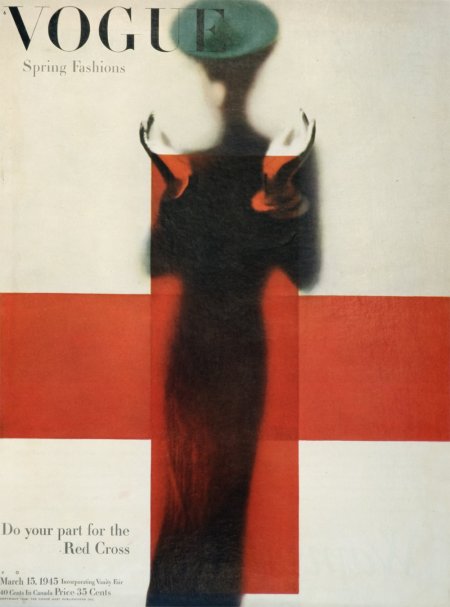 Blumenfeld’s photo on the cover of Vogue US, March 1945
Blumenfeld’s photo on the cover of Vogue US, March 1945
 Marilyn Monroe. Contact sheet from The Last Sitting photo shoot, by Bert Stern, 1962
Marilyn Monroe. Contact sheet from The Last Sitting photo shoot, by Bert Stern, 1962
 Kate Moss wearing a Louis Vuitton outfit inspired by Richard Prince. Photo by Craig McDean, Vogue UK 2008
Kate Moss wearing a Louis Vuitton outfit inspired by Richard Prince. Photo by Craig McDean, Vogue UK 2008
French fashion house Louis Vuitton commissioned a set of print advertisements in 2007 featuring luggage used by French actress Catherine Deneuve. Catherine Deneuve sits on her luggage beside a steam train. The text, “Sometimes home is just a feeling”. She holds in her hand, the “Louis Vuitton Manhattan PM”. Catherine followed up the print campaign with a short journey through Paris in film. The Journeys print campaign was developed at Ogilvy & Mather, Paris, by creative director Christian Reuilly, art director Antoaneta Metchanova, copywriter Edgard Montjean, art buyer Laurence Nahmias and photographer Annie Leibovitz.
 Robert Indiana on coach with Andy Warhol in Warhol’s studio, Vogue, March 1965. Photo: Bruce Davidson
Robert Indiana on coach with Andy Warhol in Warhol’s studio, Vogue, March 1965. Photo: Bruce Davidson
At the helm of the Pop art movement were Andy Warhol and Robert Indiana. The two artists exhibited work together at the same gallery and even posed together holding their cats in a Vogue photo spread. Indiana has been a theatrical set and costume designer, such as the 1976 production by the Santa Fe Opera of Virgil Thomson’s The Mother of Us All, based on the life of suffragist Susan B. Anthony. He was the star of Andy Warhol‘s film Eat (1964), which is a 45-minute film of Indiana eating a mushroom in his SoHo loft. But while Indiana embraced Pop, the movement didn’t suit him in many ways. He wasn’t interested in the personality cults or media attention that swirled around Warhol, and Indiana shied away from the sex, drugs, and fame.
Indiana first public commission—a 20-ft.-tall, light-studded “EAT” sign for the 1964 New York World’s Fair—referenced his mother’s years working in roadside diners, as well as her last words to him, “Did you have something to eat?” But the flashing EAT sign so resembled familiar cafe signage that people flocked to it, assuming it was a restaurant. It wasn’t the last time Indiana’s work would become simultaneously popular and misunderstood.
 Book of Love Poems, printed in 1996
Book of Love Poems, printed in 1996
Robert Indiana’s experiment with LOVE started in 1958, when he began playing with poetry, placing the letters “LO” above “VE.” He translated the idea into paintings, and in 1965, he hit pay dirt when the Museum of Modern Art commissioned him to do a version of LOVE for a Christmas card. His simple composition of vibrant red letters against a green and blue background became one of the museum’s most popular items.
The first serigraph/silk screen of Love was printed as part of an exhibition poster for Stable Gallery in 1966. A few examples of the rare image, in bold blue and green with a red bottom announcing “Stable May 66” are known to exist. Twenty-five of these, without the red announcement, were signed and dated on the reverse by Indiana. Sculptural versions of the image have been installed at numerous American and international locations. In 1977 he created a Hebrew version with the four letter word Ahava (אהבה “love” in Hebrew) using COR-TEN steel, for the Israel Museum Art Garden in Jerusalem, Israel.
 In time for the holidays, the O of the famous love sculpture by Robert Indiana was lowered. November 29, 1971.
In time for the holidays, the O of the famous love sculpture by Robert Indiana was lowered. November 29, 1971.
Although it wasn’t a critical success, LOVE was so popular with the general public that NBC televised the exhibition. In an era of love-ins and peace protests, the image struck a nerve with the spirit of the 1960s. Hippies were all about love, and for the next decade, so was Robert Indiana.
As Indiana’s LOVE spread, his name didn’t. “Everybody knows my LOVE,” he told an interviewer in 1976, “but they don’t have the slightest idea what I look like. I’m practically anonymous.” Because Indiana hadn’t wanted to disrupt his initial design with his signature or a copyright notice, he had no legal protection against imitators. He also enjoyed little financial gain as his image was ripped off in countless ways. One company sold a line of cheap cast aluminum LOVE paperweights in bookstores on college campuses; another offered LOVE and HATE cufflinks. As the number of parodies increased, Indiana eventually copyrighted some variants of his creation. But by that time, it was too late to file suit against the flood of false LOVEs on the market.
Indiana’s best known image is the word love in upper-case letters, arranged in a square with a tilted letter O. The iconography first appeared in a series of poems originally written in 1958, in which Indiana stacked LO and VE on top of one another. Then in a painting with the words “Love is God”.
LOVE is an iconic Pop Art image by American artist Robert Indiana. It consists of the letters LO over the letters VE; the O is canted sideways so that its oblong negative space creates a line leading to the V. Its original rendering in sculpture was made in 1970 and is displayed in Indiana at the Indianapolis Museum of Art. The material is COR-TEN steel Indiana’s LOVE design has since been reproduced in a variety of formats for rendering in displays around the world. Versions of the sculpture now exist in Hebrew, Chinese, Italian and Spanish as well as the original English.
MoMA historian Deborah Wye describes Indiana’s image as “full of erotic, religious, autobiographical, and political underpinnings” that make it “both accessible and complex in meaning. Megan Wilde offered more detail about the autobiographical origins in an article for Mental Floss magazine, “The word love was connected to [the artist’s] childhood experiences attending a Christian Science church, where the only decoration was the wall inscription God is Love. The colors were an homage to his father, who worked at a Phillips 66 gas station during the Depression.” She quotes Robert Indiana as describing the original colors as “the red and green of that sign against the blue Hoosier sky.”
The image has been rendered and parodied in countless forms. The original book cover for Erich Segal‘s novel Love Story alluded to the design, and the TV series Bridget Loves Bernie included a shot of the Sixth Avenue sculpture in its opening credits. The United States Post Office issued an eight-cent stamp in 1973 featuring the image. Parodies of the image appeared on covers of records by Rage Against the Machine (Renegades), Oasis (Little by Little single) and Acen (75 Minutes). Evan Greenfield’s sculpture “I’m Lovin’ It” alludes to Indiana’s image.
The first serigraph/silk screen of Love was printed as part of an exhibition poster for Stable Gallery in 1966. A few examples of the rare image, in bold blue and green with a red bottom announcing “Stable May 66” are known to exist. Twenty-five of these, without the red announcement, were signed and dated on the reverse by Indiana. Sculptural versions of the image have been installed at numerous American and international locations. In 1977 he created a Hebrew version with the four letter word Ahava (אהבה “love” in Hebrew) using COR-TEN steel, for the Israel Museum Art Garden in Jerusalem, Israel.
 In 1995, Indiana created a “Heliotherapy Love” series of 300 silk screen prints signed and numbered by the artist, which surrounds the iconic love image in a bright yellow border. These prints are the largest official printed version of the Love image.
In 1995, Indiana created a “Heliotherapy Love” series of 300 silk screen prints signed and numbered by the artist, which surrounds the iconic love image in a bright yellow border. These prints are the largest official printed version of the Love image.
Hand-painted dress and platforms by special order, Dior Haute Couture
 Portrait of Adele Bloch-Bauer I, Gustav Klimt, 1907
Portrait of Adele Bloch-Bauer I, Gustav Klimt, 1907
The first of two portraits Gustav Klimt painted of Bloch-Bauer, it has been referred to as the final and most fully representative work of his golden phase. Klimt took three years to complete the painting; preliminary drawings for it date from 1903/4. It is made of oil and gold on canvas, showing elaborate and complex ornamentation as seen in the Jugendstil style. Klimt was a member of the Vienna Secession, a group of artists that broke away from the traditional way of painting. The picture was painted in Vienna and commissioned by Adele’s husband Ferdinand Bloch-Bauer. As a wealthy industrialist who had made his fortune in the sugar industry, he sponsored the arts and favored and supported Gustav Klimt. Adele Bloch-Bauer became the only model who was painted twice by Klimt when he completed a second picture of her, Adele Bloch-Bauer II, in 1912.
Sweater and skirt, Calvin Klein
 Woman with a Fan (Madame Lunia Czechowska), Amedeo Modigliani, 1919
Woman with a Fan (Madame Lunia Czechowska), Amedeo Modigliani, 1919
Amedeo Modigliani painted this–one of ten portraits he did of this sitter–one year before his death and three years after he’d met the lovely Lunia Czechowska (1895-after 1970). The Polish woman and her husband, Casimir, were old friends of Modigliani’s patron/dealer Leopold Zborowski. Despite the facts that Lunia was very much married in 1916 and “Modi” would shortly become involved with Jeanne Hébuterne, or that the two women became so friendly that one took care of the other’s out-of-wedlock daughter, only his death caused the artist to cease attempting to seduce Lunia.
Here he shows his firm friend posed gracefully, her seated body in its yellow dress forming lithe curves against the scarlet background. Later in life, Czechowska vividly recalled sitting for Modi as he drank cheap brandy, sang, lapsed into Italian and, eventually, fell so far into the act of painting that he became oblivious to the presence of another human being. And then, there she was on canvas, left with ” … the impression of having the soul laid bare and of being in the strange position of being able to do nothing to disguise her feelings.” In hindsight, it all sounds rather more seductive than a physical seduction.
Corset, Bottega Veneta
 The Cripple, John Currin, 1997
The Cripple, John Currin, 1997
Norman Bryson opens the brilliant, anxious essay he wrote for the lavish book on John Currin with an admission: ‘When I first saw Currin’s The Cripple, what I sensed was not only the cruelty that lay within the construction of the image, but a nasty stickiness in that cruelty, a way it had of making you connive in its own malevolence.’ He goes on to explain that the ‘figure’s misshapen and twisted body evidently originates with the painter, whose attitude towards the deformation he inflicts seems to include enjoyment.’
Silk-organza petal dress with jewel brooch, by special order, Armani Privé
Ballerinas, Edgar Degas, 1884
In this pastel, Edgar Degas revisited a theme he had already tackled in his work in the 1870s – ballerinas resting. He also went back to his regular studies on the effects of contre-jour, lighting which “reduces to silhouette”, suppressing details, erasing the distinctive features of a face or a body, making them anonymous.
But while still employing the old formulae, Dancers was innovative in its size and composition, and without doubt, is the best example of what has been called Degas’ “classical period”. Around 1884, the painter, in fact, simplified his compositions, reduced the depth of his pictorial space, lowered the viewpoint to make it more natural and concentrated on one, single character or group of figures. At the same time, he abandoned the often caricatural approach of his previous works. In doing this, he was responding to a desire expressed by critics and the public: to protest “against the confused mass of colours and the jumble of indecipherable lines that are destroying contemporary painting”. From this point of view, Dancers is effectively a manifesto.
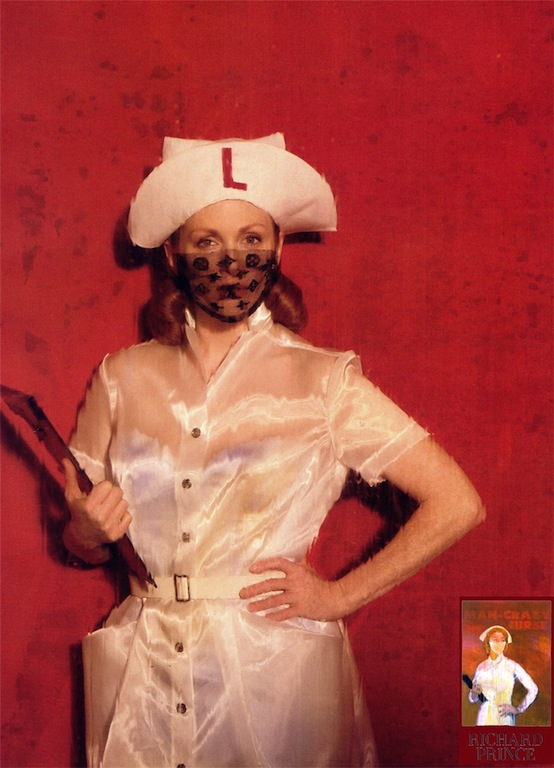 Sheer dress, slip-dress, hat, mask and belt, Louis Vuitton
Sheer dress, slip-dress, hat, mask and belt, Louis Vuitton
 Man-Crazy Nurse, № 2, Richard Prince, 2003
Man-Crazy Nurse, № 2, Richard Prince, 2003
Man-Crazy Nurse #2 plays the role of the ultimate femme fatale in Richard Prince‘s celebrated series of nurse paintings. Her full-blooded lust barely concealed by her primly buttoned and starched white uniform, she clutches a standard-issue hospital clipboard as if checking off the names of the men she has devoured. Casting a side-long glance, this libidinous nurse seems to have her next patient/victim in sight. Prince’s lushly expressive brushwork, which floods the canvas in shades of fleshy pink and blood red, serves as both a come-on and a warning.
Prince painted Man-Crazy Nurse #2 in 2002, the year he started working on his nurse series, and it was included in his first exhibition of these works at Barbara Gladstone Gallery the following year. In this body of work, Prince appropriated the covers of pulp romance novels from his collection of vintage books and transferred them onto canvas using an ink-jet printer, which he then layered with vigorous skeins of color. He veils his nurses with surgical masks that both add an element of mysterious allure, and turn them into potentially menacing masked bandits. In some cases he retains the original title, while in others he substitutes another novel’s title, and heightens ambiguity by blocking out the elements that provide any narrative mooring for his protagonists. The original covers often included handsome doctors or patients, or scenes of lovers caught in rapt embraces, which Prince subsums into a hazy fog of luridly colored paint.
A voracious bibliophile — an obsession which he has documented in various artist’s books such as American English (2003) — Prince has for years amassed an extensive collection of secondhand books and memorabilia, ranging from titles on film noir and trash literature to letters, manuscripts, publicity pictures, and first editions of favorites such as Lolita.
Photographs by Peter Lindbergh, Harper’s Bazaar, May 2008





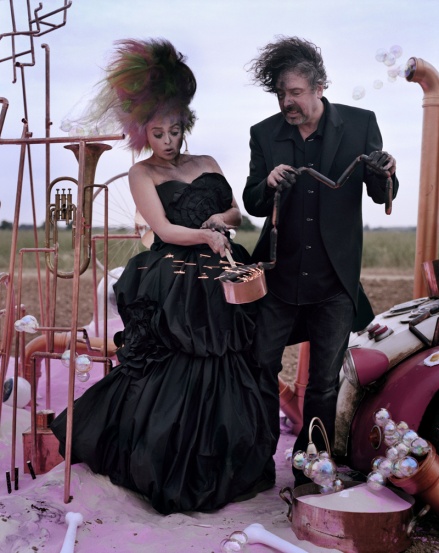










 Photos by Tim Walker for Vogue UK, December 2008
Photos by Tim Walker for Vogue UK, December 2008
Tim Walker creates this candy coated acid trip of a universe featuring models Karen Elson, Georgia May Jagger, and Sophie Drake, as well as various actors, designers, and British eccentrics, including Tim Burton and Helena Bonham Carter. The story uses quotes from Roald Dahl stories and the editorial includes an article by Dahl’s granddaughter, model Sophie Dahl.
by Jade Reason
La vía del estilo
Art still has truth. Take refuge there.
Tales from Tinseltown...recording them now...I'll let you know when it's story time.
My Work My Art My Show - new school Sex and the City
All my words that are fit to print (and other's too!)
Making Life more Beautiful
Tulio Silva
Life, Leisure, Luxury
MYTHS AND HISTORIES OF A RELUCTANT BLOGGER
All my aimless thoughts, ideas, and ramblings, all packed into one site!
Meaning in Being. You be you.
Poetry, musings and sightings from where the country changes
Cooking is personalization.
Creativity is within us all